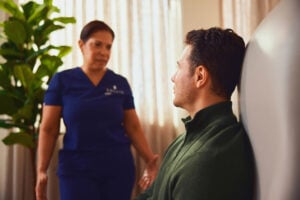Summer Camp Sports
According to an American Academy of Pediatrics report on summer camp safety, two-thirds of reported events are illnesses and the other third are common injuries like cuts, scratches, and scrapes. Roughly 15% of the injuries are fractures and 10% are sprains or strains. The most dangerous activities are horseback riding, capture the flag, and falling off bunk beds and playground equipment.
Before you trust a camp with your child’s safety, make sure their staff is trained in first aid and emergency protocol. Tell camp personnel about your kid’s medical conditions, allergies, and any medications they’re taking. You should also teach your child basic first aid, warn them about common injuries, and go over safety rules so they know how to act when you’re not around.

When to go to the ER
- Severe headache or vomiting, especially after a head injury
- Bleeding that won’t stop within 10 minutes of pressure
- Inability to stand or unsteady walking
- Loss of consciousness
- Difficulty breathing
- Skin or lips that look blue, purple, or gray
- Smoke inhalation
- Difficulty eating
- Animal or snake bite
- Coughing or vomiting blood
- Severe, persistent, or increasing pain
- Confusion or delirium
- Fever accompanied by a change in behavior
For everything else that happens at camp—from mild illnesses to dehydration to any other non-life-threatening conditions—you can always call our 24/7 medical hotline.
Water Sports
Drowning is the leading cause of injury-related death for kids age 1 to 4 and amounts to an average of three kids every single day. It’s also a leading cause of accidental death for ages 5 to 19, and for every child who dies from drowning, another seven receive emergency care. While it occurs in every type of water—lakes, oceans, streams, bathtubs, buckets, inflatable pools—the majority happens in home swimming pools, and often when kids aren’t even swimming: they wander into a neighbor’s yard or even fall into a kiddie pool filled with rain water. The good news is, knowing how to prevent it and react in the moment can save a child’s life.
Minimizing your risk
First and foremost, learn CPR. Start swimming lessons for your kids early, but don’t ever assume they’re safe, even once they learn—especially in natural bodies of water, where currents and debris can be major hazards. Always have adult supervision and make sure the adult is free of distractions like alcohol, cell phones, etc. For infants and toddlers in the water, “touch supervision” is key: an adult should always be within an arm’s length. It’s also important to remember that kids drown quickly and silently—not with a loud splash / flailing like in the movies—and often when they’re vertical in the water with their head tipped back. You should intervene even if a child is only slightly in trouble, not at the point of drowning. Don’t count on a lifeguard, either: they don’t always catch everything.
As for flotation devices, young kids should wear a Type III U.S. Coast Guard-approved life preserver, not a pool toy like water wings or a noodle—but even a USCG life jacket is not a replacement for adult supervision. If you have a pool, install a fence and consider additional safeguards like automatic door locks and alarms. Lastly, don’t forget to look for signs of dry or delayed drowning after a swim (when water gets into the lungs and builds up) including trouble breathing, coughing, fatigue, irritability, chest pain, or vomiting.
What to do if a child is drowning
- Get them out of the water and call 911. If they aren’t breathing, place them on their back on a firm surface.
- Begin CPR. Gently tilt the child’s head back with one hand and lift their chin with the other and check for signs of breathing. If they don’t seem to be breathing and are under the age of one, place your mouth over their nose and lips and give two rescue breaths, each lasting one second. If they’re older than one, pinch their nose and seal your lips over their mouth. Give two slow, full breaths lasting one to two seconds. Wait for the chest to rise and fall before giving the second breath.
- If the chest doesn’t rise and fall, retilt the head, lift the child’s chin, and repeat the same steps.
- Begin chest compressions. Place the heel of one hand on the center of the chest at the nipple line. For an infant, place two fingers on the breastbone. Press down at least two inches (or 1.5 for an infant) and do 30 chest compressions at a rate of 100/minute. Let the chest rise completely between pushes. Check to see if the child has started breathing.
- Never assume it’s too late to save a child’s life. Even if they’re unresponsive, continue alternating between 30 chest compressions and two rescue breaths until emergency help arrives or the child starts to breathe normally.
Tee Ball and Biking
While most of the injuries that happen on the tee ball diamond are limited to scrapes, cramps, sprains, and the occasional bruised young ego after a strikeout, there’s always the potential for something more serious like a head injury. It’s important to remember that when it comes to concussions, the symptoms are not always obvious or immediate in young children. Your child won’t necessarily lose consciousness and they don’t have to suffer a blow to their head to have one—it could be a hit to the body, collision, fall, or whiplash-type injury.
As for bike injuries, an average of 25 kids every hour go to the ER with bike-related cuts, bruises, fractures, scrapes, and head injuries. During a recent 10-year study, nearly half of the injuries involved kids 10 to 14, 75% were boys, brain trauma comprised 11%, and the incidents occurred most frequently in the street or at home. The best way to prevent your kids from becoming one of those statistics is to make sure they wear a properly-fitted helmet every time they ride a bike (and no hats under the helmet!). Teach them road safety rules, including obeying traffic signals and using hand signals for turning. Have them wear bright colors and use lights on their bikes. Whenever possible, choose bike-friendly routes with designated bike lanes or low-traffic areas. You should also check your child’s bike regularly, including their brakes, tires, and reflectors.
What to do if your child has a concussion
- Take them out of the game or off the bike immediately. A second blow to the head before fully recovering from the first concussion can lead to severe brain damage.
- Look for red flags that indicate they need immediate care: they appear dazed, confused, can’t remember things before the concussion, lose consciousness (even briefly), or have personality changes. If they do, call our 24/7 medical hotline.
- Take your child to the ER for an evaluation if they experience weakness, numbness, loss of coordination, nausea or vomiting, slurred speech, severe headache, difficulty staying away, trouble waking up, one pupil larger than the other, or seizures. These symptoms may occur immediately or after the fact.
- Be on alert for 24 to 48 hours. Watch for signs of worsening symptoms.
- Give them time off from school and electronics. As long as you’ve talked to a doctor, let them sleep. Sleeping longer than usual is expected while their brain heals.

What to do if a child is bleeding
- Apply pressure with a clean cloth, tissue, or gauze. Do not remove the material even if it becomes blood-soaked.
- Go to Sollis or an ER immediately if the bleeding can’t be stopped with pressure within 10 minutes, blood is spurting out of the wound, the cut is on the child’s face, ear, or neck, dirt / debris is stuck in the wound, or if you suspect internal bleeding.
- If the wound is on a leg or arm, try to raise it above the heart, which will help stem the bleeding.
- Do not wait. If a cut needs stitches, it must happen within 18 to 24 hours.
- If you have any concerns, call our 24/7 medical hotline for guidance.
If a child has a broken bone
- Call 911 immediately if there’s an injury to the head, neck, or back, if a bone comes through the skin, or if there’s heavy bleeding.
- Keep your child lying down and gently take or cut clothing off the injured area without moving it.
- For a minor fracture, put ice on it, elevate it if possible, and use a simple splint to keep it temporarily stable.
- While waiting for help, do not move the injured body part, wash it, or push in any part that’s sticking out. Do not let your child eat or drink in case they need surgery.
- If you have any concerns, call our 24/7 medical hotline for guidance.







